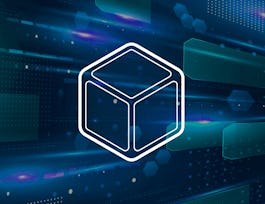For most of the last century, critical advances in technology were happening inside large, well-funded industrial R&D machines that dotted the Western world. Today’s landscape, however, is very different. Even the largest and most sophisticated corporate leaders can no longer dominate their fields or dictate the pace of development. With companies across sectors seeking to harness the transformative potential of blockchain technologies, the blockchain ecosystem is an exemplar of new models of industry collaboration.



Web3 and Blockchain Leadership for Transformation
This course is part of Web3 and Blockchain in Global Commerce Specialization



Instructors: Don Tapscott
Sponsored by ITC-Infotech
1,714 already enrolled
(12 reviews)
What you'll learn
Describe how blockchain consortia may vary with respect to their purpose, activities, membership models, beneficiaries, and governance models
Describe some of the benefits and key considerations concerning shared standards for blockchain and digital assets
Explain how blockchain design choices around privacy, user identity, security, notaries, block relays etc. influence interoperability implementations
Explain how blockchain will transform the roles and functions of the C-Suite
Skills you'll gain
Details to know

Add to your LinkedIn profile
34 assignments
See how employees at top companies are mastering in-demand skills

Build your subject-matter expertise
- Learn new concepts from industry experts
- Gain a foundational understanding of a subject or tool
- Develop job-relevant skills with hands-on projects
- Earn a shareable career certificate


Earn a career certificate
Add this credential to your LinkedIn profile, resume, or CV
Share it on social media and in your performance review

There are 5 modules in this course
Blockchain alone is just a tool. In order for this technology to fulfill its long-term promise, humans must lead. Rather than relying on state-based institutions, blockchain must be primarily self-governed through collaborations of civil society, private sector, government, and stakeholders in non-state networks. In this module, we discuss the idea of blockchain governance networks and explain how they can support blockchain stewardship at three levels: The platform level, the application level, and the ecosystem level. As well, you will learn about the conditions that are necessary for a blockchain-based hub of innovation to succeed.
What's included
16 videos3 readings4 assignments1 discussion prompt
Although blockchain technology emerged from the open source community, it quickly attracted many stakeholders, each with different backgrounds, interests, and motives. In this module, you will explore the roles and perspectives of nine categories of stakeholders within the blockchain ecosystem, including industry pioneers, venture capitalists, developers, governments, regulators, leaders, and end users.
What's included
8 videos2 readings4 assignments1 discussion prompt
Because blockchain changes the deep structures and architecture of the firm, it will consequently transform our models of management and the roles of the C-Suite. Navigating the balance between blockchain’s hype and its true potential is a key responsibility of an organization’s management team. In this module, you will learn about some of the decisions and changes that business leaders can anticipate when considering how the future of blockchain will unfold within their business.
What's included
11 videos8 readings14 assignments
With companies across sectors seeking to harness the transformative potential of distributed ledger technologies (DLT), the blockchain ecosystem is an exemplar of new models of industry collaboration. Coopetition—the strategy of cooperating with competitors for defined purposes to cultivate a new economic ecosystem that benefits both—has become the new norm. In this module, you will learn what companies are trying to gain from consortia projects, and what industries and competitors need to accomplish to get to a win-win. You will discuss various design options, organizational models, and best practices for consortia projects, and will explore several examples of industry consortia that are at the forefront of the blockchain ecosystem.
What's included
7 videos3 readings5 assignments
While most professionals understand the potential of blockchain technology, not all of them understand its mechanics and the requirements for its success. In the last decade, thousands of blockchain projects have sprung up, all intending to become the dominant blockchain protocol. A clear winner has not yet emerged, leading to numerous attempts to communicate and transfer value between different blockchain networks. In this module, you will learn about two major themes concerning the exchange of data and value across blockchain protocols: standardization and interoperability. You will learn how various types of standards—including semantic standardization and technological standardization—can create powerful network effects and economic gains for members of a blockchain ecosystem. You will also learn about various approaches to interoperability among blockchain networks. You will explore a series of recent interoperability projects (e.g. Aion, Chainlink, Cosmos, Polkadot) and will discuss some of the implementation challenges and opportunities concerning blockchain interoperability solutions.
What's included
13 videos4 readings7 assignments
Instructors


Offered by
Why people choose Coursera for their career




Recommended if you're interested in Business

Johns Hopkins University

University of California, Irvine

Open new doors with Coursera Plus
Unlimited access to 10,000+ world-class courses, hands-on projects, and job-ready certificate programs - all included in your subscription
Advance your career with an online degree
Earn a degree from world-class universities - 100% online
Join over 3,400 global companies that choose Coursera for Business
Upskill your employees to excel in the digital economy




